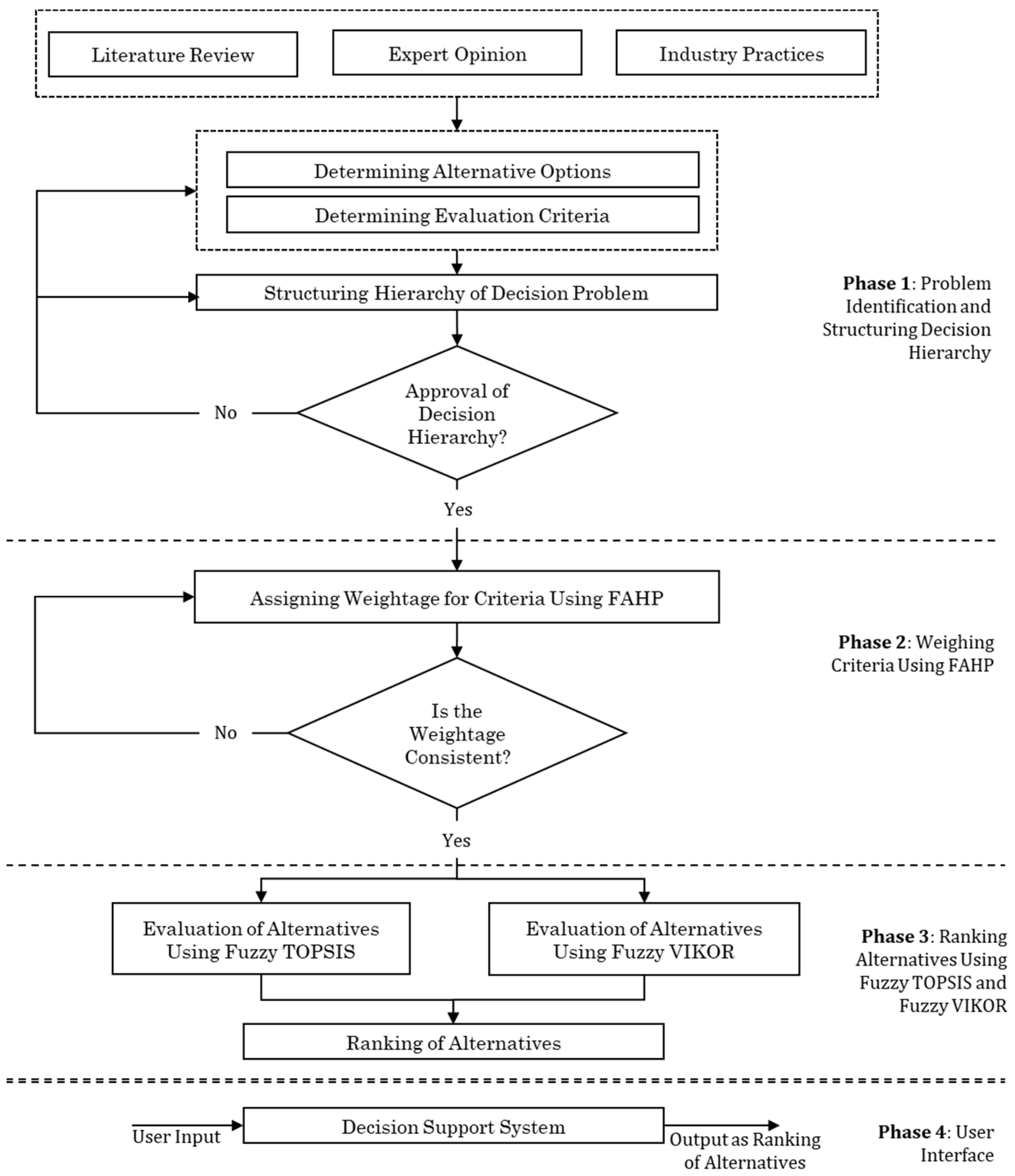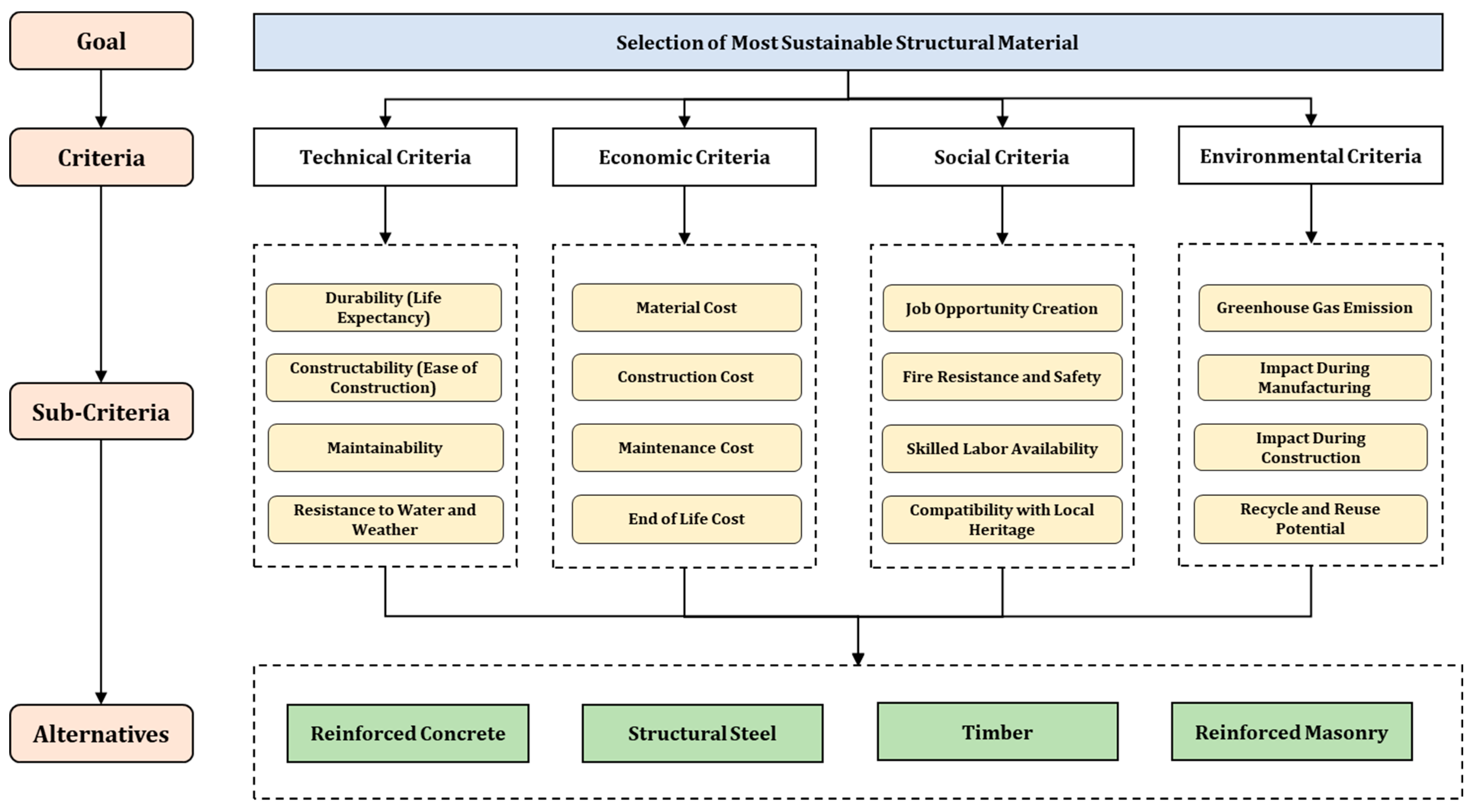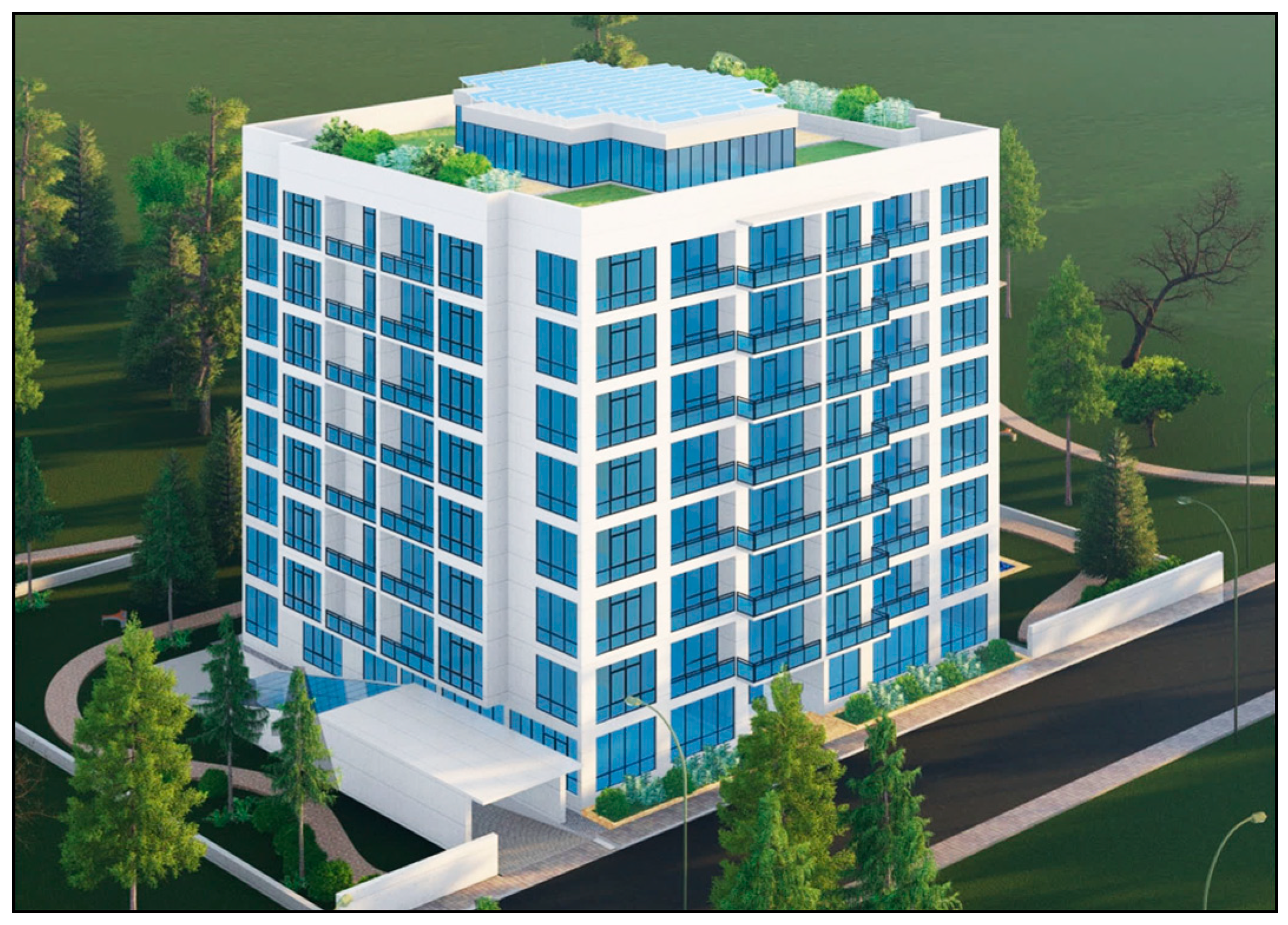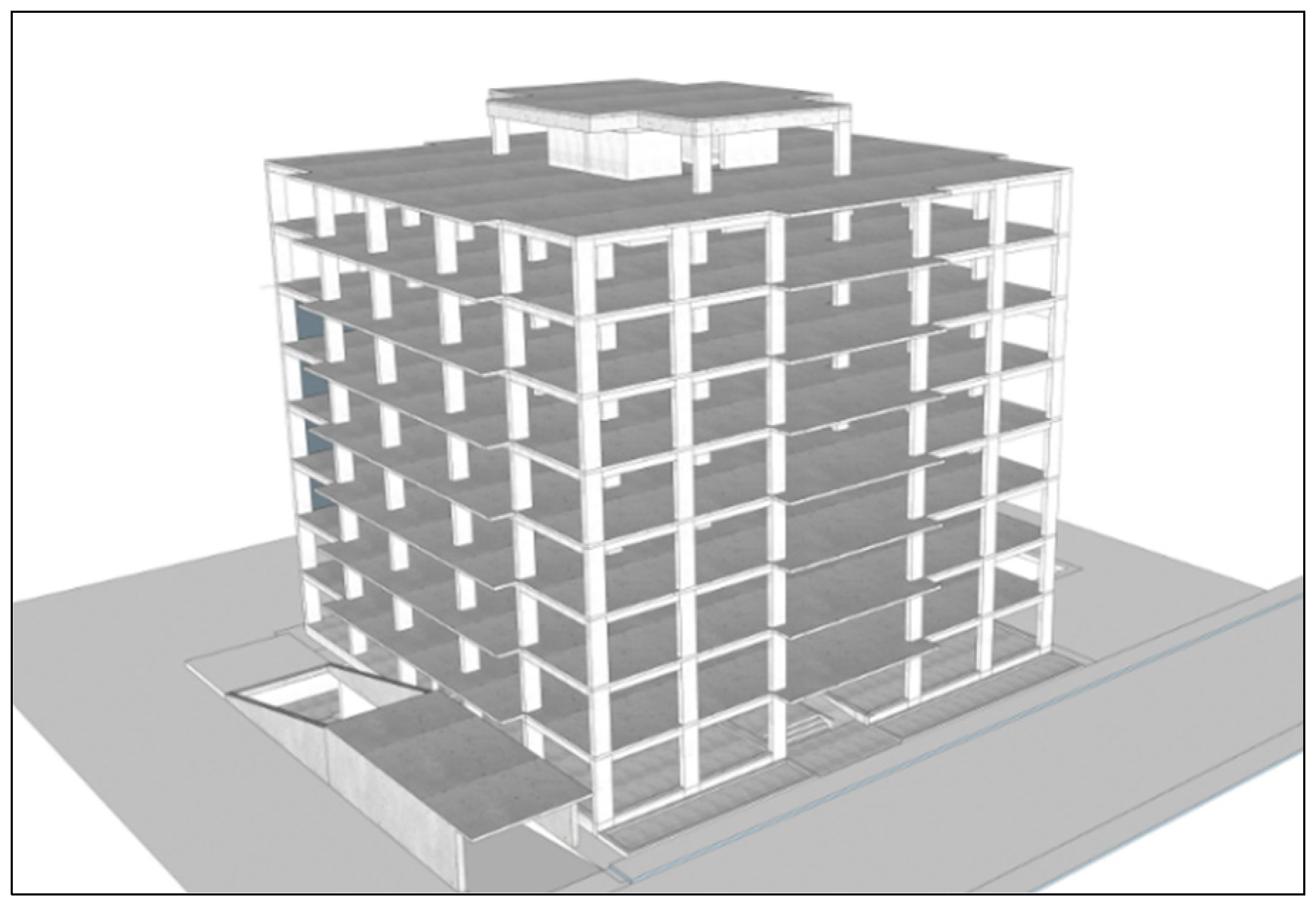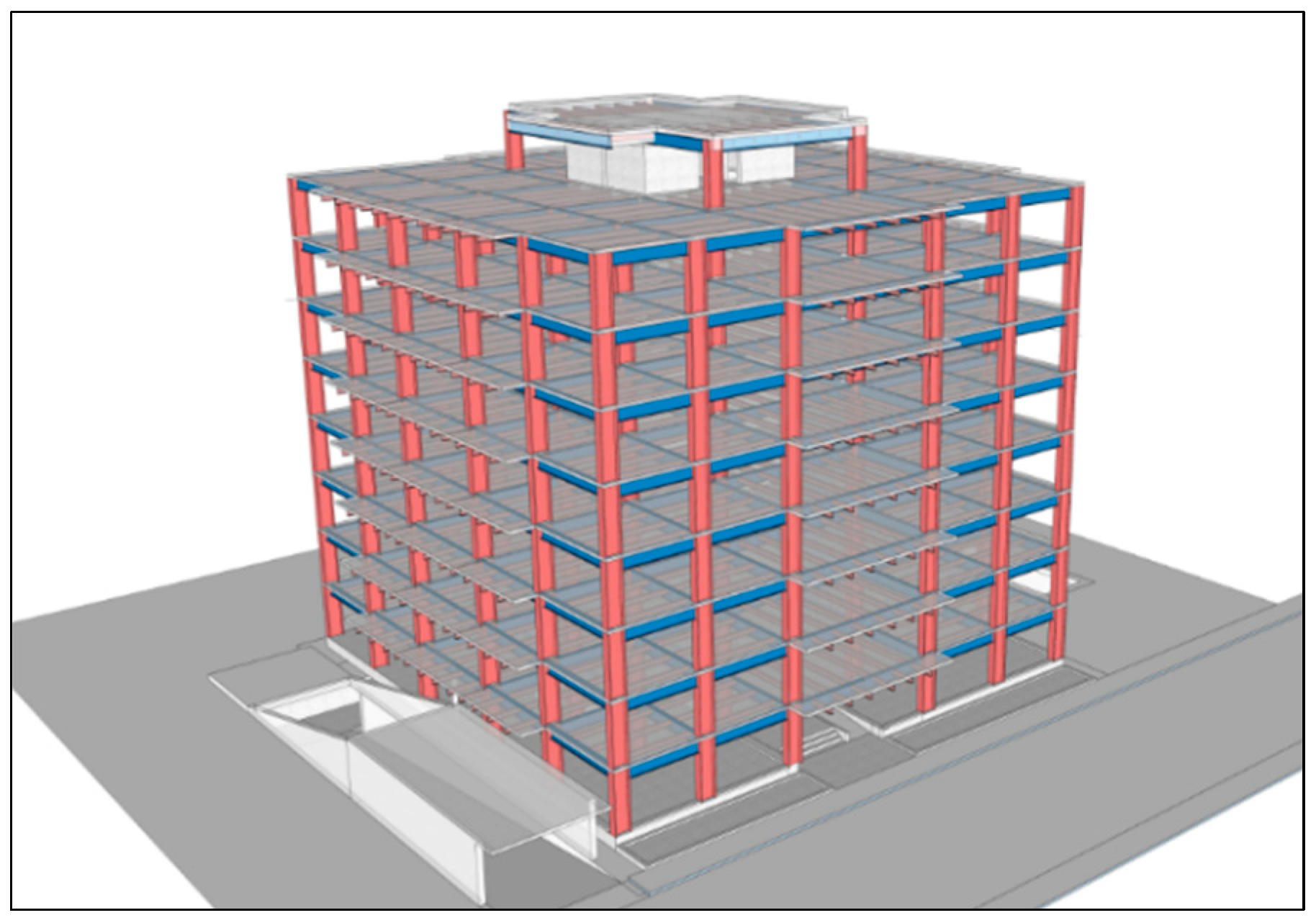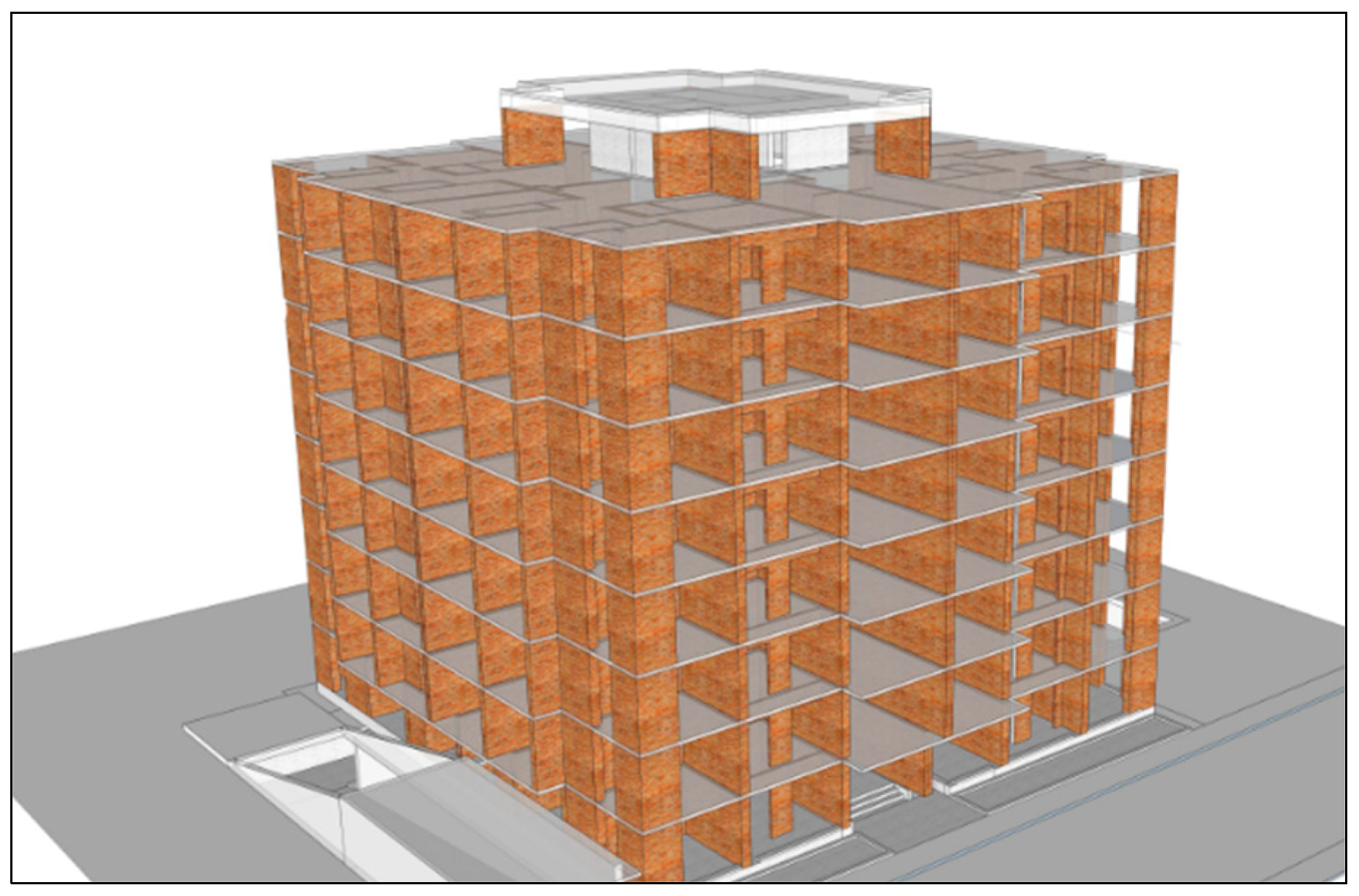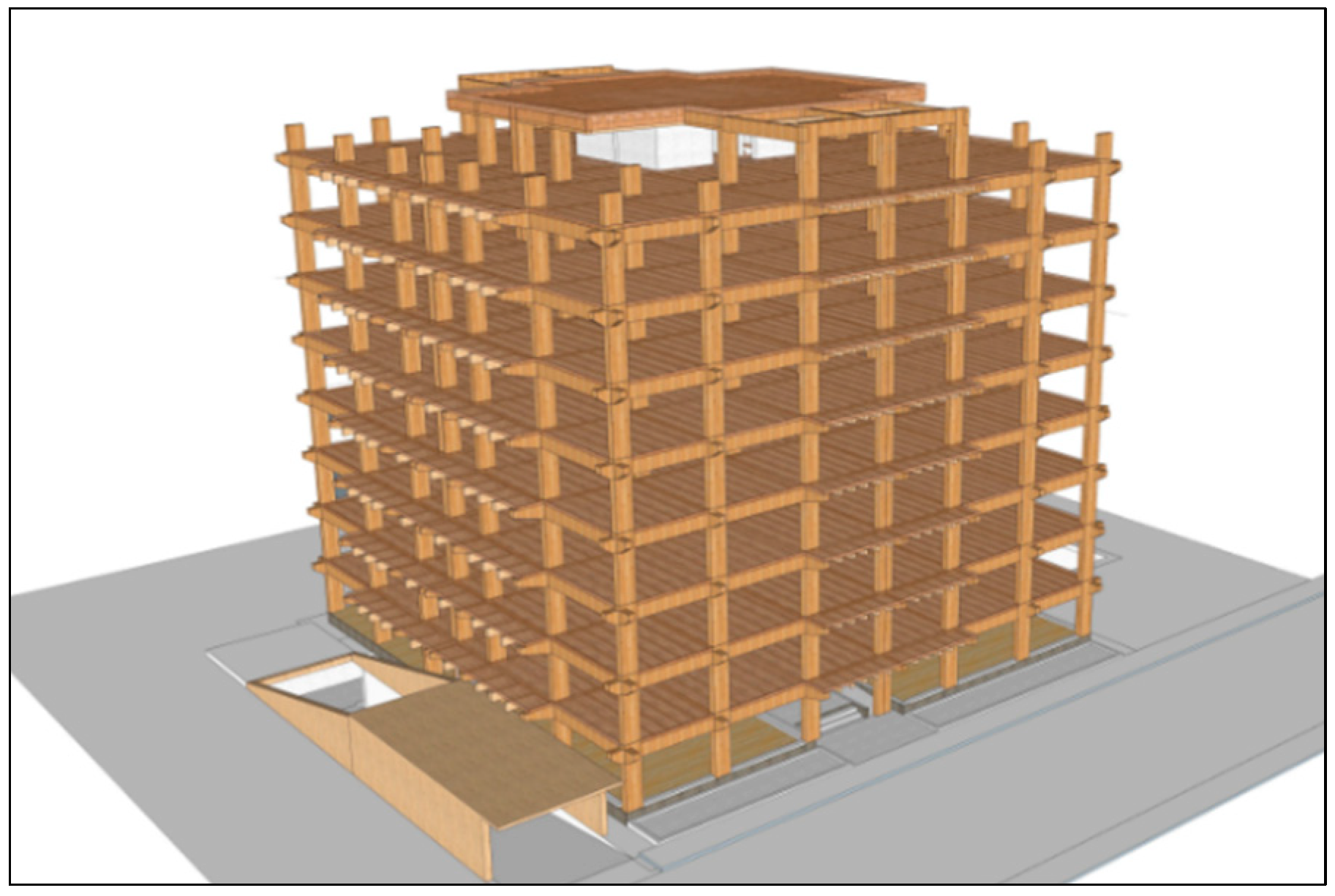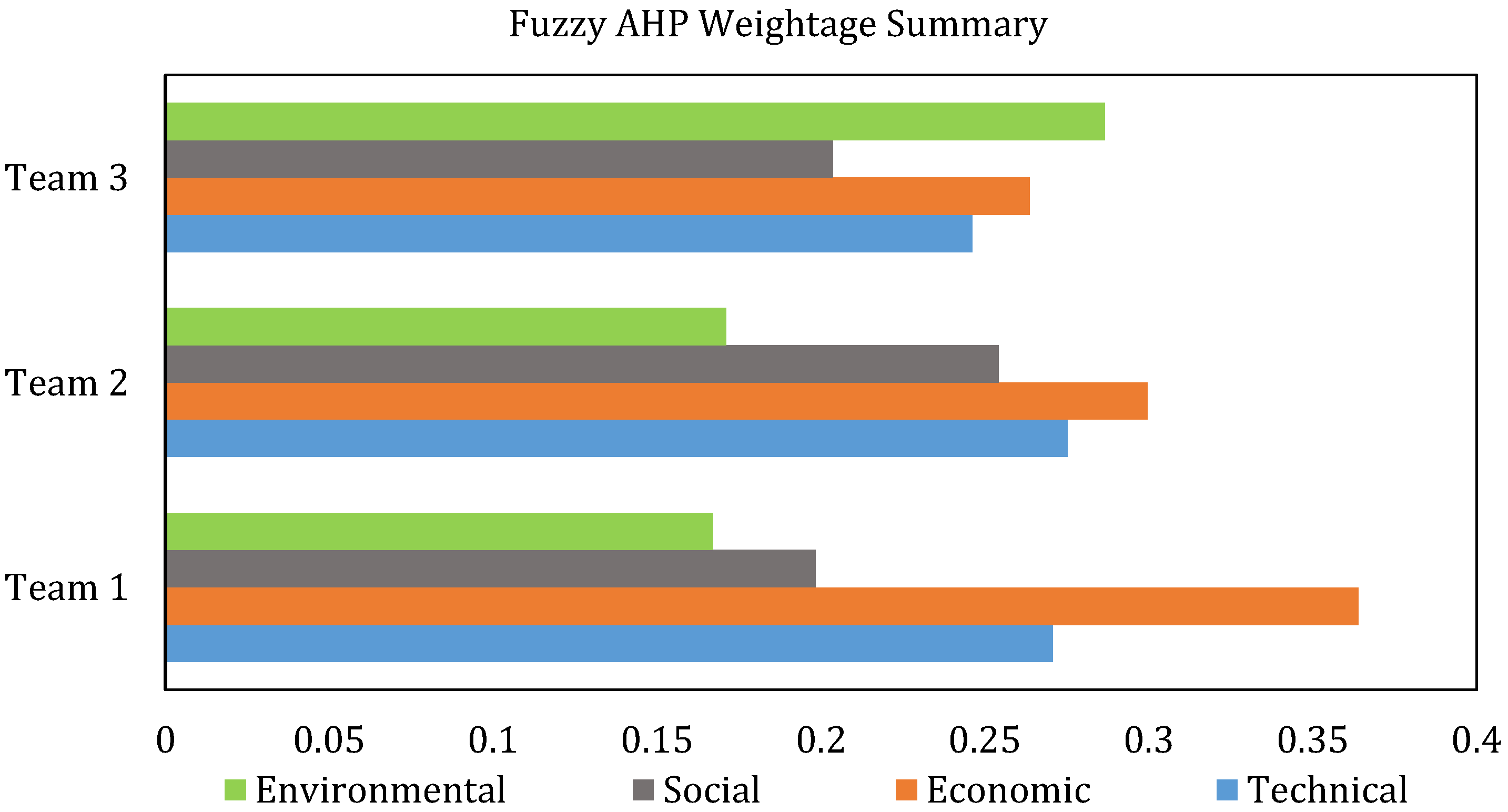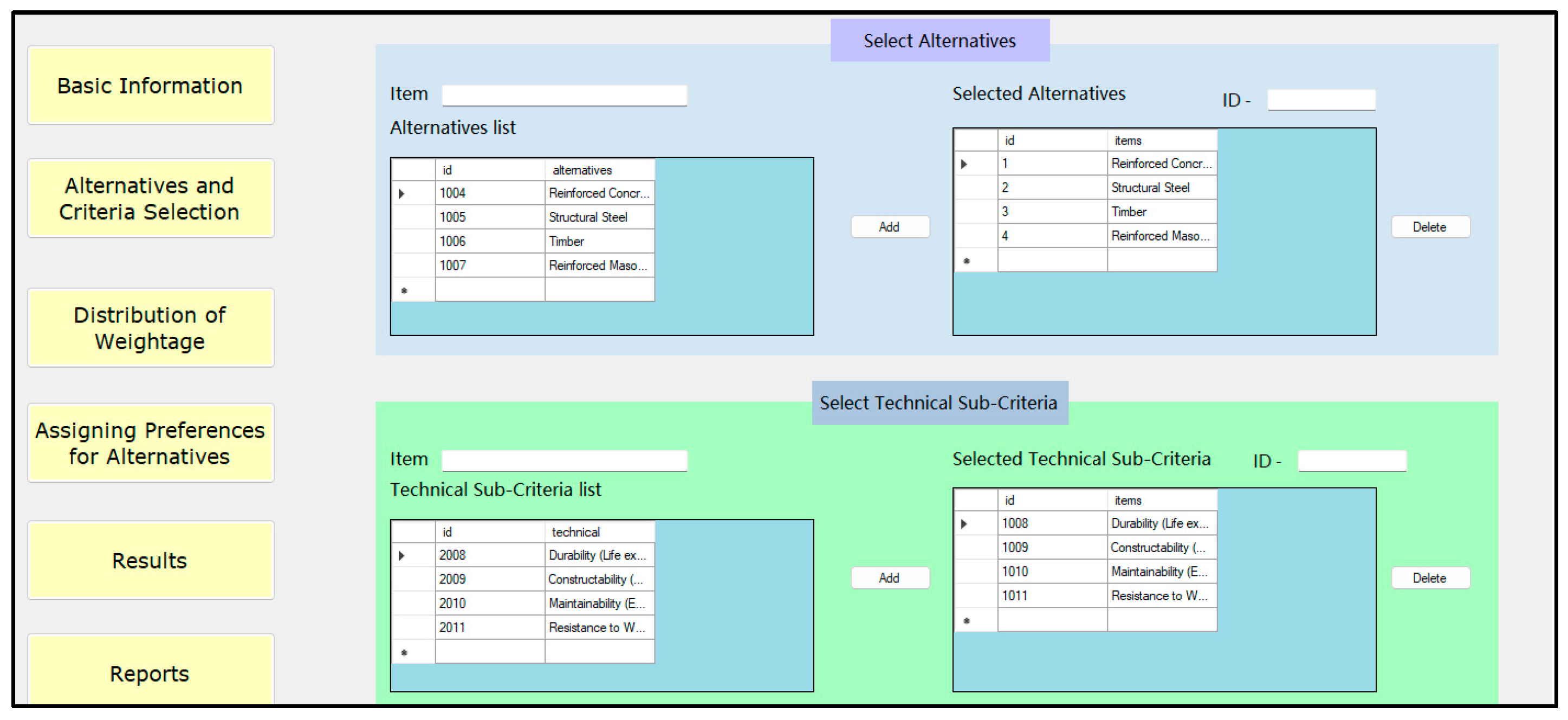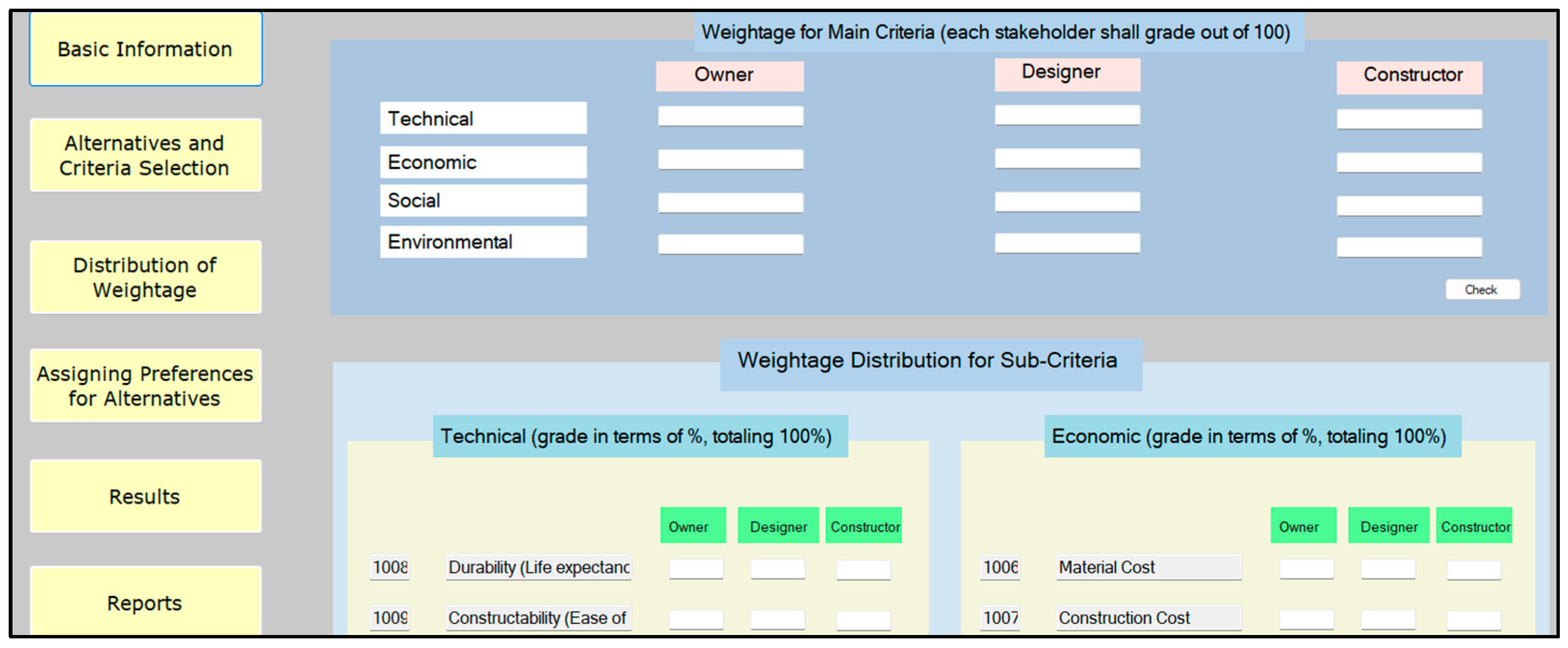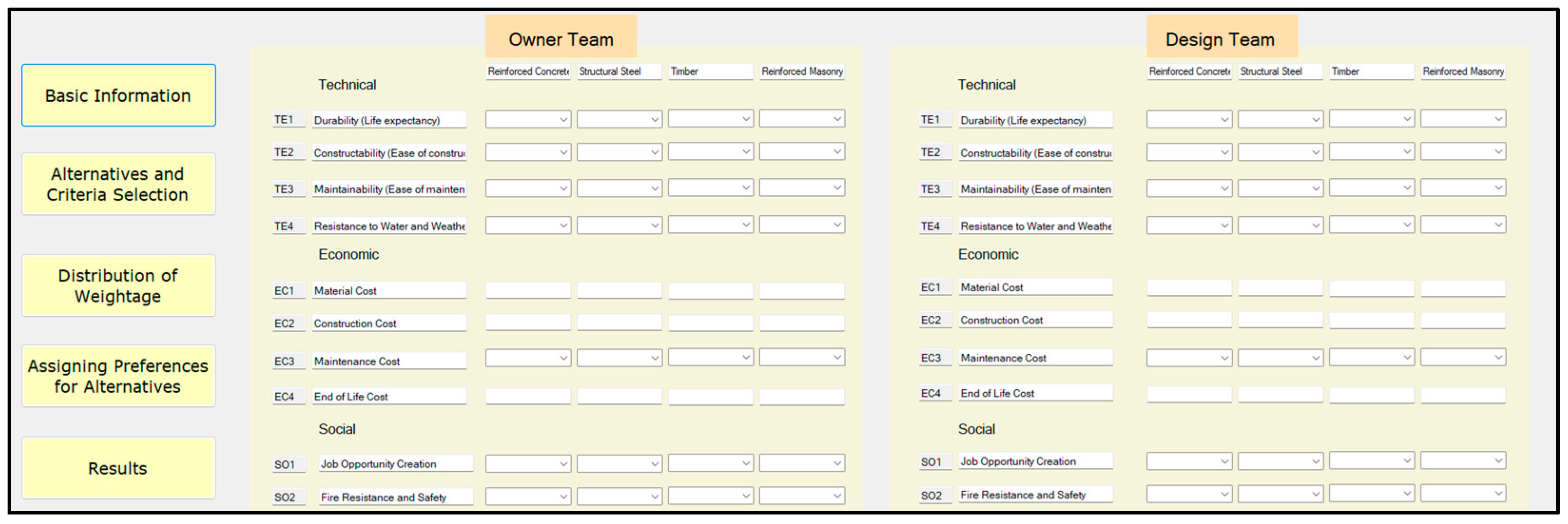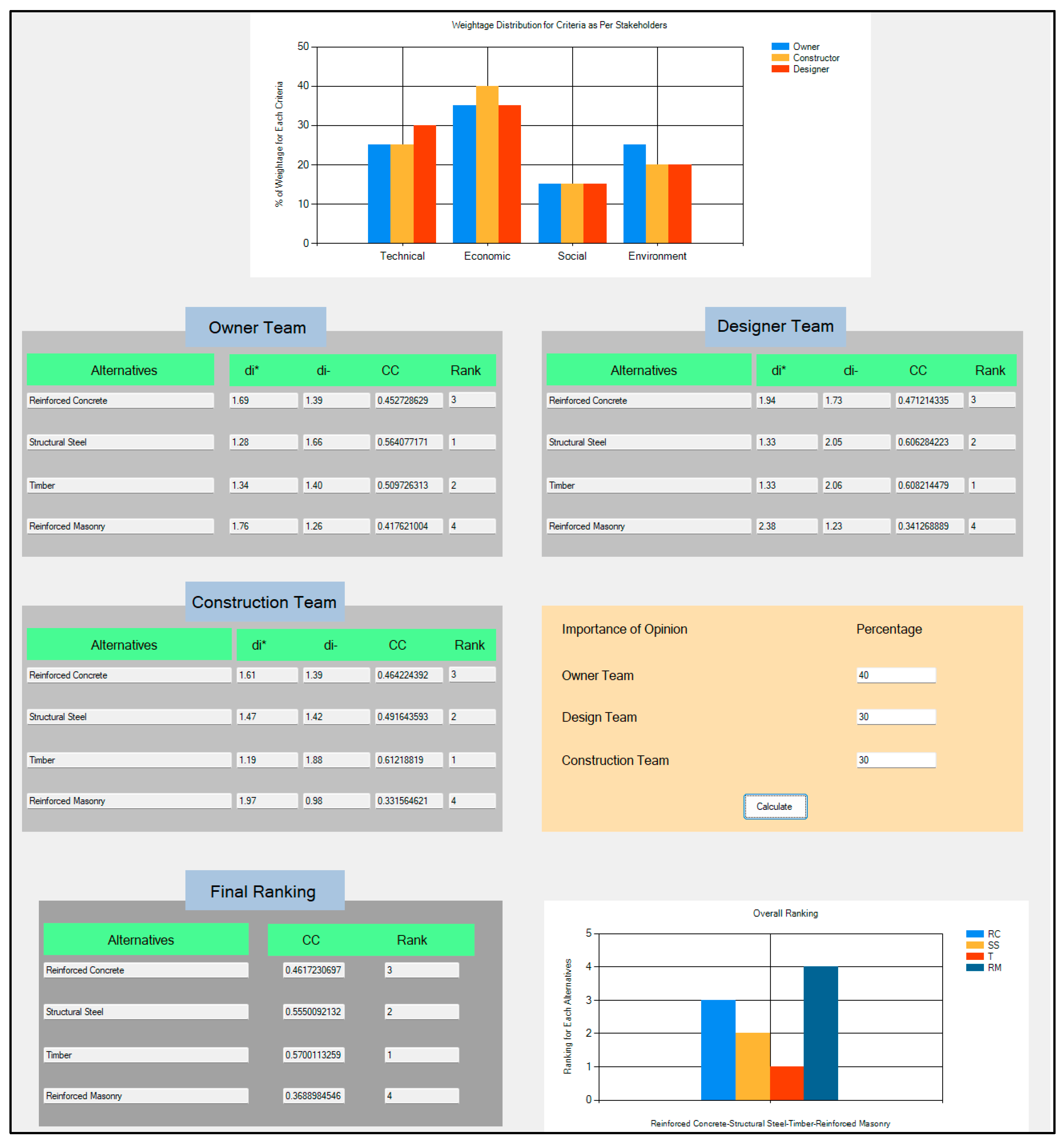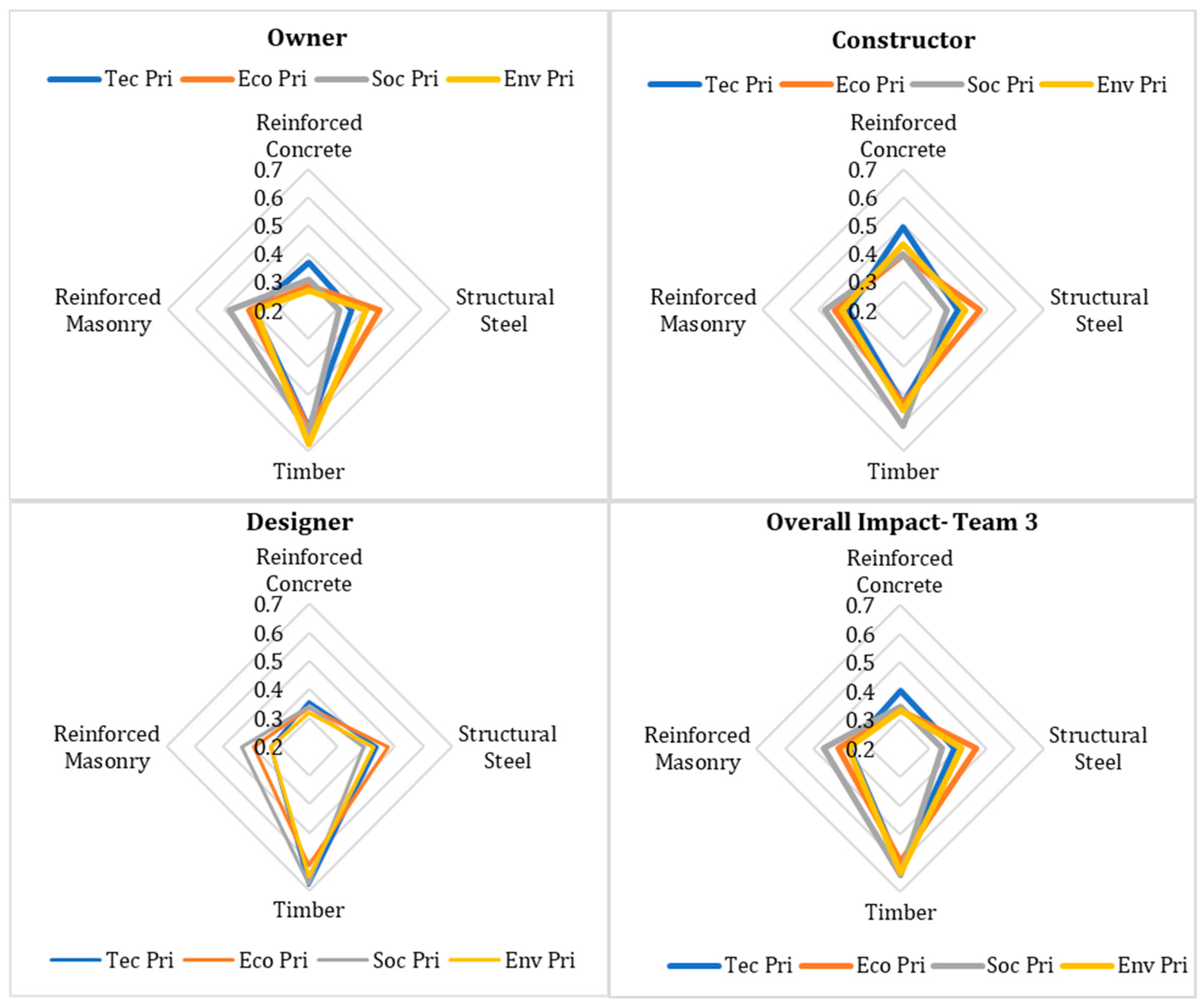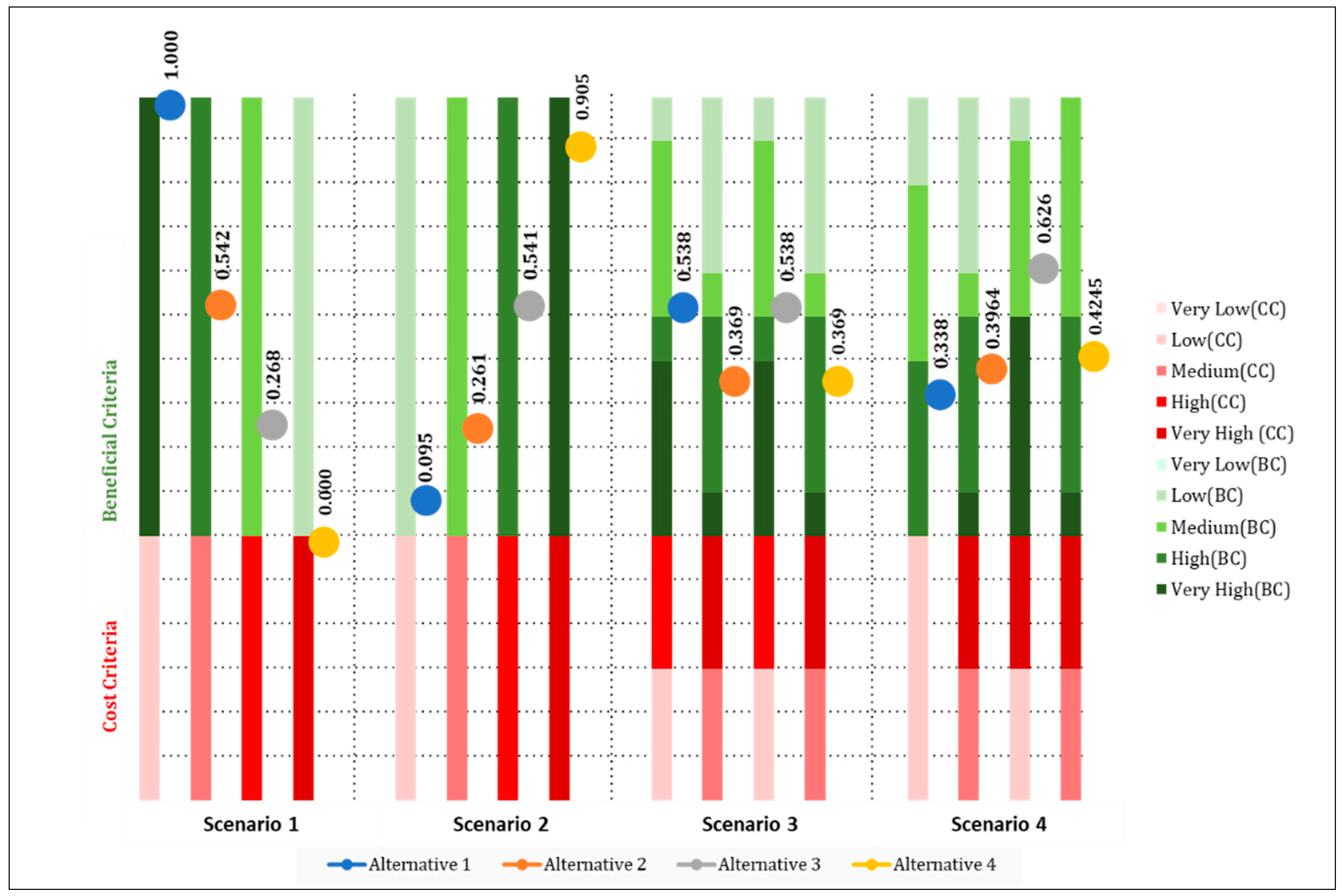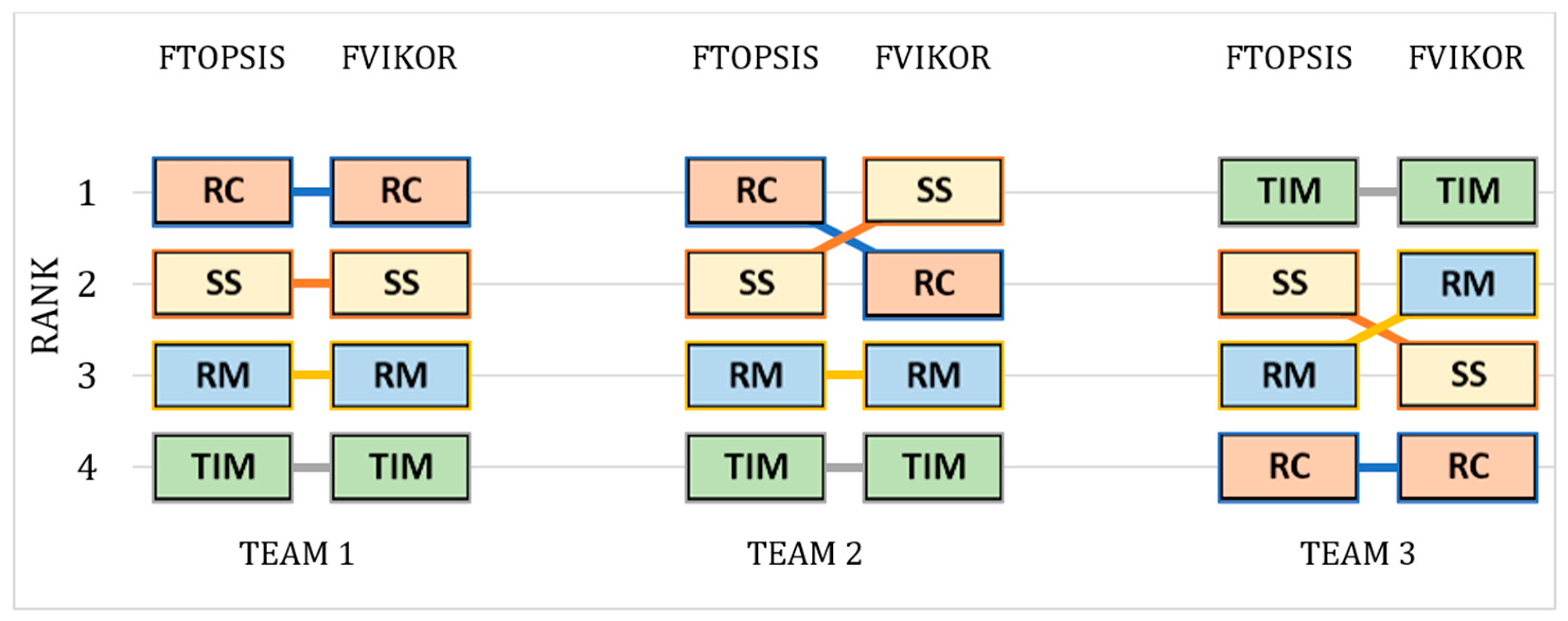1. Introduction
Over time, the construction industry’s development has been constantly questioned due to issues such as low productivity, high energy consumption, the generation of waste, and greenhouse gas emission. Buildings and their associated construction industries account for 36% of global energy use and 37% of energy-related carbon dioxide (CO
2) and greenhouse gas emissions [
1]. The Construction User’s Roundtable (2022) reported that the productivity of construction works has significantly reduced in the last 50 years compared to other sectors [
2]. Another report showed that construction-related spending accounted for 13% of the world’s GDP, but its annual productivity growth increased by 1% over the past 20 years. It also presented that
$1.6 trillion of additional value could be created through higher productivity, meeting half the world’s infrastructure needs [
2]. During the ‘UN Climate Change Conference’, UK, 2021, all 26 of the participating nations of the COP (conference of the parties) collectively agreed to work to reduce greenhouse gas emissions to limit the rise of the global average temperature to 1.5 degrees Celsius [
3]. Therefore, the construction industry desperately needs better resource efficiency, improved productivity, less waste, and increased value.
Sustainable construction aims to achieve ‘maximum value with minimum harm,’ ensuring the balance between economic, social, and environmental factors in a project, commonly known as the pillars of sustainability [
4,
5,
6]. These pillars of sustainability were introduced by the World Summit on Social Development of the United Nations held in 2005 [
7]. Sustainable construction is a holistic process that promotes harmony between nature, humanity, and the built environment by creating settlements that suit humans and support economic equality [
8]. It applies sustainable development principles to a building life cycle from planning the construction and mining and preparing the raw materials to production, creating construction materials, usage, the destruction of construction, and the management of waste [
8].
Structural elements of a building generally consist of beams, columns, tension members, and their connections [
9]. The selection of the structural material in the case of building construction plays a vital role as it acts as the backbone of the structure and demands vast resources. In general, concrete, timber, steel, masonry, composite (timber–steel, timber–concrete, steel–concrete), etc., are used to construct multistory buildings. Reinforced concrete (RC) is the most commonly used structural material for building construction. However, ironically, concrete is one of the leading sources of environmental degradation and is harmful to the ecosystem and environment [
10]. Structural steel (SS) may be used to replace concrete due to its numerous advantages, including strength and flexibility. Nevertheless, it requires a significant amount of energy during manufacturing and may be expensive in some situations [
11]. Masonry is a time-tested alternative to concrete construction. However, burned bricks may emit significant levels of carbon during the manufacturing process, and masonry construction requires a substantial amount of cement [
12]. As a building material, timber has a better energy-saving and carbon-reduction performance than other traditional materials. However, a lack of design standards and fire-resistance issues are commonly highlighted as impediments, inhibiting timber use as a structural material for multistory buildings, unlike masonry, concrete, or steel [
13]. This phenomenon has led to a rethink regarding alternative building construction materials to achieve sustainability.
Making a sustainable decision is always critical as it combines several technical, social, economic, and environmental factors. From the literature review, it was identified that several studies have been carried out on the selection of building materials, sustainability indicators of materials, etc. The findings showed that construction industries select structural materials by considering the technical and economic aspects, and there was a lack of any sustainable decision-making system. Most of the previous research in this area either focused on technical or economic aspects only or considered three pillars of sustainable construction. From interviews with several industry experts, it was also identified that the decision regarding the selection of structural materials commonly considers technical and economic factors. There is no structured tool to integrate all stakeholders’ opinions or assess the overall aspects of sustainable construction in the selection process.
In particular, the objective of this research was to develop a decision support system that would integrate all stakeholders’ preferences into an IPD framework for selecting the most sustainable structural material from technical, economic, social, and environmental sustainability points of view. The activities associated with the fulfilment of the research objectives include the identification of structural materials used for multistory building construction through the literature review, industry practices, and expert opinion; sustainability analysis (technical, economic, social, and environmental aspects) of the structural materials in use with the help of the tools available (LCC, LCCA, etc.) and expert opinion; review of the selection process for structural materials from the perspective of sustainable construction practices; several interview sessions with industry experts, project owners, design teams, and constructors, conducted in addition to the literature review, to determine the details of existing practices; the development of sub-criteria for all of the pillars of sustainable construction, primarily through the literature review, and then validating and finalizing them with feedback from industry and academic experts; and development of the DSS using MCDM techniques to aid the selection of the most sustainable structural material for multistory building construction.
The remarkable contributions of this research comprise the integration of technical aspects with the commonly used three pillars (economic, social, and environmental) for sustainability assessment, including a case study; the application of two different MCDM methods (Fuzzy TOPSIS and Fuzzy VIKOR) to rank alternatives with Shannon’s entropy to handle qualitative and quantitative data, and trapezoidal membership functions to obtain more realistic results; and the development of a DSS application that shall assist decision makers in choosing evaluation criteria and assigning relative importance to those criteria in the combination of qualitative and quantitative methods in an IPD framework, not only to select the most sustainable structural material but also to solve a wide range of construction-related problems.
The rest of the paper is organized as follows:
Section 2 provides a comprehensive picture of past research.
Section 3 explains the data collection and analysis process used in this study.
Section 4 presents a case study to validate the theoretical model.
Section 5 discusses the details of the DSS desktop application software.
Section 6 explains the sensitivity analysis to verify the appropriateness of model output.
Section 7 and
Section 8 present the discussions and conclusions to describe the usefulness and benefits of the study.
3. Material and Method
3.1. Sustainability Evaluation Criteria
There can be a variety of sustainability evaluation criteria (i.e., sub-criteria under four main criteria) for assessing the technical, economic, social, and environmental pillars of sustainable construction. From the literature review, it was observed that researchers have used different sets of evaluation criteria based on the type and nature of the construction projects. The selection of sub-criteria was also dependent on the user’s preferences. Therefore, to finalize the list of sub-criteria in selecting the most sustainable structural material, we sought the opinion of several industry experts and academic researchers. A summary of sub-criteria based on overall findings is shown in
Table 1. However, this list is not applicable to all cases, and users can modify it according to the location and nature of the projects and the preferences of the stakeholders.
3.2. MCDM Methods Chosen for This Research
As discussed, AHP and TOPSIS are currently the most widely used MCDM techniques in construction. With the exception of a few cases, these methods were combined with fuzzy theory to eliminate crisp values and introduce vagueness to handle uncertainties, imprecision, or a lack of information. Fuzzy AHP (FAHP) is one of the most powerful and extensively used tools to assign weightage to criteria in MCDM. Therefore, it was used in this research to assign weightage to the sixteen chosen criteria. Though the triangular membership function is most widely used in FAHP for its simplicity, the trapezoidal function is considered to handle uncertainties, imprecision, or a lack of information in a better way. Therefore, the trapezoidal membership function was used in this research. Fuzzy TOPSIS was chosen to rank the alternatives as it is a widely used, familiar, and easy tool for decision-making that has acceptance in both industry and academia. However, a relatively new and less familiar tool, fuzzy VIKOR, was used in parallel to rank the alternatives. Fuzzy VIKOR was used to compare the results with a different technique and validate its reliability. It is expected that a comparison of results through fuzzy TOPSIS and fuzzy VIKOR was likely to enhance the acceptance of fuzzy VIKOR in construction. This study generated a TOPSIS extension that integrated subjective and objective weights. In addition to the subjective weights determined by decision makers, this study derived subjective weights from objective values using Shannon’s entropy as a basis [
73,
74].
3.3. Research Framework and Hierarchy of the Decision Problem
This study considered four alternative options of structural materials (RC, SS, RM, and timber) and sixteen evaluation criteria, taking four from each pillar of sustainable construction, as mentioned in
Table 1. The weightage of criteria was calculated using fuzzy AHP with a trapezoidal membership function. Fuzzy TOPSIS and fuzzy VIKOR were used to rank the alternatives using the weightage obtained through fuzzy AHP. Fuzzy TOPSIS was used to develop the DSS software out of two ranking methods. The details of the research framework are shown in
Figure 1 and the hierarchy of the decision problem is shown in
Figure 2.
The first phase of this research identified the structural materials in use for multistory building construction and reviewed the selection process, followed by the industries from the perspective of sustainable construction practices. An extensive literature review was conducted in the initial stage, and later, a series of interviews and discussion sessions were conducted with industry and academic experts to learn about the selection process, preferences of structural materials, sustainability options considered, etc. In phases two and three, the most appropriate decision-making techniques for solving this problem were selected by studying different research papers. The data for quantitative sub-criteria were obtained through structural analysis, market survey, and the use of the Athena Impact Estimator for the Buildings software. The information for the qualitative sub-criteria was collected from industry and academic experts. They were also requested to assign weightage for each sub-criteria. Next, fuzzy AHP was used to calculate the weightage of all sub-criteria, and fuzzy TOPSIS and fuzzy VIKOR were used to rank the alternatives. The fourth phase of this research developed a decision support computer application to help determine the most sustainable option from several viable alternatives. Finally, the model was validated through a case study and expert opinion.
3.4. LCA and LCCA Calculations
For the life cycle effect evaluation, this study used the Athena Impact Estimator for Buildings, version 5.4. While other LCA tools are available for different parts of the world, the Athena Impact Estimator for Buildings is the only North American tool for whole-building life-cycle assessment based on the globally recognized LCA methodology [
75,
76]. This application offers a cradle-to-grave LCA of structures, which includes resource extraction, manufacture, construction, related transportation, maintenance, replacement impacts, building operation destruction, and disposal [
75]. The LCA technique employed in these investigations was based on ISO 14044 [
77].
3.5. Normalizing Objective Values into Subjective Inputs
In addition to the subjective weights determined by the decision makers, this study derived subjective weights from objective values using Shannon’s entropy as a basis [
73,
74].
Step 1: To determine objective weights using the entropy measure, the decision matrix needs to be normalized for each criterion (
Cj,
j = 1, 2…
n;
n = is the criteria number), to obtain the projection value
Pij of each:
where
m = number of alternatives.
Step 2: After normalizing the decision matrix, we can calculate the Shannon diversity index as
Step 3: Now, the following equation is used to find out the Shannon Equitability Index or the entropy to measure the evenness of the values in particular criteria. The entropy value is denoted as
ej:
where
m = the total number of alternatives considered in the decision-making process.
Step 4: Now, the degree of divergence can be calculated as dj = 1 − ej. The higher the value of dj, the higher the degree of divergence. Within the matrix, the criteria values containing a higher degree of divergence are considered for the range distribution of subjective values.
3.6. Fuzzy AHP
The AHP is one of the most widely used MCDM tools that can be used to analyze, measure, and synthesize decision problems [
67]. There have been numerous applications of the AHP, including selecting among competing alternatives in multi-objective environments, allocating scarce resources, and forecasting [
78]. For determining the relative priorities of different selection criteria and sub-categories, Fuzzy AHP uses fuzzy numbers as a pairwise comparison scale. This approach can adequately handle the inherent uncertainty and imprecision of human decision-making processes and offer an appropriate level of flexibility and robustness so that a decision maker can comprehend and understand a decision problem [
54]. The steps of the calculations are explained as follows [
79,
80]:
Step 1: Generate a Comparison Matrix.
Details of pairwise comparison criteria are given in
Table 2 and the equation that defines pairwise comparisons is given below:
where
i,
j = 1, 2, 3,…
n.
Here, n denotes the number of criteria compared, wi is the weight for criterion i, and aij is the ratio of the weights of criteria i and j.
Step 2: Normalizing the Matrix.
After determining the comparison of its criteria in
Table 2, the next thing is to normalize the matrix. This is carried out by dividing each cell by the summation of that column value. Here,
Step 3: Developing Criteria Weightage.
Criteria weightage is the average weightage of each row:
Step 4: Checking for Consistency.
Saaty listed the values in a set to compare the consistency index (CI) with a random generator (RI) value [
81]. This value is variable with the matrix order
n. The following equation is used to calculate the eigenvector:
Here,
is the eigenvector. Now we have to find out the λ (lambda) value:
After obtaining the maximum lambda value, the value of the consistency index (CI) can be determined.
Here, CI is the consistency index and λmaks is the largest eigenvalue of the n-order matrix. It is acceptable to tolerate the inconsistency of each opinion if the CR of a matrix is smaller than 10% (0.1).
Step 5: Fuzzification.
The given weights need to be fuzzified based on
Table 3 given below.
Step 6: Fuzzified Normalized Weight and Global Ranking.
Finally, the normalized fuzzy weight is calculated as
3.7. Ranking of Alternatives with Fuzzy TOPSIS
TOPSIS is widely used for solving ranking problems in real situations [
79]. The fundamental concept of TOPSIS is that the chosen alternative should be closest to the positive ideal solution (PIS) and the furthest away from the negative ideal solution (NIS) [
82]. TOPSIS defines an index called similarity (or relative closeness) to the PIS and the remoteness from the NIS. Then, the method chooses an alternative that has maximum similarity to the PIS [
83]. The classical TOPSIS method uses a precise weighting of the criteria and crisp values for rating the alternatives. Even though it is popular and simple in concept, the classical technique has often been criticized for its inability to adequately deal with the inherent uncertainty and imprecision involved in mapping the decision maker’s perception into crisp values [
79]. In order to address the shortcoming of traditional TOPSIS, several fuzzy TOPSIS methods and applications have been developed in recent years that utilize linguistic variables expressed by fuzzy numbers to determine how to evaluate criteria and alternatives [
82,
84,
85].
In this study, we presented a TOPSIS modification that considers both subjective and objective weights. The advantage of the developed approach is that it uses decision makers’ experience and tangible (numerical input) information from end users throughout the decision-making process. The steps of the calculations are explained below [
80,
86,
87].
Step 1: Input Parameter (Preferences) from the Users.
In this step, a matrix is formed comprising the preferences given by the users (
Table 4).
Step 2: Set up Trapezoidal Fuzzy Number (TrFN) and Transform the User Input into the Fuzzy Decision Matrix.
In the FAHP scale, the trapezoidal fuzzy number (TrFN) has four boundary values
a,
b,
c, and
d: The degree of membership increases between
a and
b, flattens between
b and
with a degree of 1 (i.e., values between
c and
d fully belong to the category), and then decreases between
c and
d (
Figure 3). Each fuzzy set representing the categories described in
Table 5 was represented by trapezoidal membership functions (
Table 3 and
Figure 4).
Step 3: Calculation of the Combined Fuzzy Decision Matrix.
After the AHP comparison value is transformed into the FAHP scale value, a combined decision matrix is formed. The process of obtaining a fuzzy combined decision matrix value is shown using the equation of the following formula:
where
,
,
and
,
Step 4: Calculation of the Normalized Fuzzy Decision Matrix Based on Beneficial (Positive) and Cost (Negative) Criteria.
Now we need to identify the benefit (positive) and cost (negative) criteria and compute the fuzzy decision matrix:
Then, the decision matrix is normalized using the following equation:
Step 5: Normalized Fuzzy Decision Matrix Based on a Single User’s Input.
Then, the matrix value is multiplied by the fuzzy normalized weight of each criterion obtained from the fuzzy AHP.
Step 6: Deriving Fuzzy Ideal Solution, Fuzzy Positive Ideal Solution (FPIS), and Fuzzy Negative Ideal Solution (FNIS).
Now, from the matrix, fuzzy ideal solutions are obtained by the following:
Fuzzy Positive Ideal Solution (FPIS):
where
Fuzzy Negative Ideal Solution (FNIS):
where
.
Step 7: Distance from FPIS and FNIS.
Now, the distance from each alternative is calculated using the following formula:
where
;
a2,
b2,
c2,
d2 =
A*
for the
positive distance and A− for the
negative distance.
Step 8: Calculation of Closeness Coefficient.
Now the closeness coefficient (
CCi) of each alternative are calculated as
The higher value of CCi gets a higher ranking order.
Step 9: Ranking and Selection of Decisions.
For the number of members (
N) in a team, the combined decision is calculated as
where
Nimportance = the
importance of the
Nth member in the
team and
N = the
total number of members.
3.8. Ranking of Alternatives with Fuzzy VIKOR
Opricovic developed the VIKOR method in 1998 for the multi-criteria optimization of complex systems [
88]. VIKOR focuses on ranking and sorting a set of alternatives against various or possibly conflicting and non-commensurable decision criteria [
89]. Similar to other MCDM methods such as TOPSIS, VIKOR uses an aggregating function to express closeness to the ideal. However, unlike TOPSIS, where the ranking introduces an index considering closeness to the ideal solution, this technique employs linear normalization to eliminate units of criteria functions [
90]. In many instances, an extension of VIKOR, such as fuzzy VIKOR, is utilized to generate a fuzzy compromise solution for MCDM cases [
91]. The steps of the calculations are explained as follows [
89,
90,
92]:
Step 1: The input parameters are assessed and weighted beneficial (positive) and cost (negative) criteria are chosen.
Step 2: Linguistic terms are converted into the fuzzy Scale, as shown in
Table 5 previously.
Step 3: The importance of the decision makers’ judgement is determined, and their weights for each criterion are computed (
Table 6).
Step 4: Generation of combined decision matrix of the team.
The process of obtaining a fuzzy combined decision matrix value is shown using the equation of the following formula:
where
Step 5: Now, both the benefit (positive) and cost (negative) criteria are identified, and the normalized fuzzy decision matrix is computed as
Step 6: Defuzzification: The normalized fuzzy decision matrix is normalized as
Step 7: The best element of criteria ( and worst element of criteria are calculated as follows:
For beneficial criteria,
and for non-beneficial criteria
Step 8: The value of utility measure (
Si), regret measure (
Ri), and VIKOR index (
Qi) are calculated as
where
Si and
Ri denote the utility measure and regret measure for the alternatives
xi, and
Wi is the weight of each criterion. Now, we compute the values of
S* = min (
Si),
S− = max(
Si),
i = 1, 2, 3…
m.
We determine the values of
Qi for j = 1, 2, 3…
m and rank the alternatives by values of
Qj:
where
v is the weight for the strategy of maximum group utility and 1 −
v is the weight of the individual regret. Usually,
v is 0.5, and when
v > 0.5, the index of
Qj will tend toward majority agreement, and clearly, when
v < 0.5, the index of
Qi will indicate a majority of negative attitudes. With the smallest number being the best option, the three values,
Si,
Ri and
Qi are ranked from biggest to smallest in ascending order.
4. Case Study
This research used a case study on an eight-story building to validate the theoretical model. A practical example with numerical computation of user, project, and structural data was essential to derive the model’s output in terms of ranking alternatives. The case study also assisted in creating several scenarios to verify the developed system’s consistency and sensitivity. Details of the case study are discussed in the subsequent paragraphs.
4.1. Description of the Case Study
The primary reason for selecting an eight-story building is that all chosen options of structural materials (RC, SS, RM, and timber) remain acceptable alternatives for this height. The Athena Impact Estimator for Buildings has an inbuilt database for Calgary, Canada; therefore, the structure’s location was chosen for ease of LCA and LCCA calculations. Eighty years of building life expectancy were considered according to the guidelines of Infrastructure Canada for five-story or more apartment buildings [
93]. Other details of the building are given in
Table 7. The architectural view of the building and structural layout with different material options are shown in
Figure 5,
Figure 6,
Figure 7,
Figure 8 and
Figure 9.
The data from three teams comprising nine members were used in this case study. Each team had a representative from the owner, constructor, and design teams who were experts in their relevant fields. The members of the study teams were the project owners, prime consultants, chief structural engineers, principal architects, project coordinators, project managers, and academic researchers from some leading Canadian construction companies, such as Clark Builders, Stantec, GEC Architecture, RJC Engineers, Alberta Masonry Council, Chandos Construction, Wood Works, and the University of Alberta. It is important to note that the members of Team 1 and Team 2 were from several leading construction industries, whereas Team 3 was formed from academic researchers and people who were already practicing sustainable construction. Details of the team members are given in
Table 8.
4.2. Calculation of LCA and LCCA
The Athena Impact Estimator for Buildings application was used to determine the quantity of construction materials required to build the model building. The cost criteria were then computed using the Alberta, Canada market rate, and the emission rate was calculated using the environmental analysis module of the same application. Results are tabulated in
Table 9.
4.3. Normalizing of the Quantitative User Input to Qualitative Value
Step 1: The inputs of
Table 9 were normalized by dividing each cell value by the sum value of each column (total criteria values for all alternatives). The obtained normalized decision matrix is shown in
Table 10.
Step 2: The Shannon diversity index measures the diversity of range values for any criterion among the alternatives. The results are shown in
Table 11, with the lowest greenhouse gas emission value (kg CO
2 equivalent/sqm) factoring in at 1.28.
Step 3: Shannon’s equitability index (
Table 11) represented the value of Shannon’s diversity index divided by the logarithm value of the total number of alternatives considered in the decision-making process. It is also called the entropy value.
Step 4: The degree of divergence was calculated by subtracting the Shannon equitability index from the unit value, as shown in
Table 12. These range values were considered to transform all other criteria values of the matrix from objective to subjective values.
Step 5: Finally, the normalized values for
Table 9 inputs were tabulated in
Table 13, equalizing with the ranges shown in
Table 12.
4.4. Calculation of Weightage for Each Criteria Using the Fuzzy AHP
4.4.1. Criteria and Codes
The names of the evaluation criteria and codes for them are listed in
Table 14. The subsequent results were generated based on the input of one stakeholder (owner of Team 3) using the formula and procedure described in
Section 3.
4.4.2. Calculation of Weightage for Each Criterion
Steps 1 and 2: A pairwise comparison matrix was developed for each user to compute the relative priorities of criteria from the user’s point of view. Each criterion was evaluated with the others on a nine-point scale, as described. Each cell was then divided by the column sum to obtain the normalized value.
Steps 3 and 4: Typically, obtaining an acceptable consistency value was complicated once there were many criteria to be evaluated with each other. The users performed a few trials and errors to achieve consistent values. The sample calculation of the consistency check of one of the users (designer, Team 3) is shown below:
Here, n = 16. CI = = 0.1306.
RI for n = 16 was 1.59.
So, CR = 0.1306/1.59 = 8.25% < 10%, which was an acceptable result.
Steps 5 and 6: The crisp values were fuzzified using the fuzzification table. Fuzzy normalized weights were obtained and ranked in ascending order. Depending on the input in the pairwise comparison matrix, the result of the fuzzified normalized weightage of the criterion varied from user to user.
Table 15 shows the fuzzified normalized weight of the criteria used by all the stakeholders in this study.
4.5. Ranking of Alternatives with Fuzzy TOPSIS
Step 1: Five options were available to the user: “Very High, High, Medium, Low, and Very Low” for twelve subjective criteria. Additionally, a total of four criteria were fixed for a specific location and time and had an objective value. These values were transformed from objective to subjective using the Shannon entropy method, which is shown in
Table 13. Finally, normalized user inputs for all evaluation criteria are shown in
Table 16.
Steps 2 and 3: The user input table was then transformed into a fuzzy decision matrix using the trapezoidal membership function described in
Section 3. The combined decision matrix was the combination of three stakeholders’ fuzzy input values of the same team.
Steps 4 and 5: The normalized fuzzy decision matrix was calculated based on the criterion category, whether it was a beneficial or a cost criterion. For beneficial criteria, the membership function was divided by the maximum value of the sets; for the cost criteria, it was reciprocal of the values divided by the minimum values of the set. The weighted normalized fuzzy decision matrix was based on the owner’s input and criteria weight derived from the fuzzy AHP.
Steps 6 and 7: Deriving the fuzzy ideal solution; The fuzzy positive ideal solution (FPIS) and fuzzy negative ideal solution (FNIS) were derived from the weighted normalized fuzzy decision matrix. The Euclidian distance of each criterion of any alternative was measured in this step. Distance from the FPIS is shown in
Table 17 and distance from FNIS is shown in
Table 18.
Step 8: The alternative was ranked based on the value of
CCi in descending order as shown in
Table 19.
Step 9: The final combined result (
Table 20) of Team 3′s stakeholders was calculated using the weights assigned to each person multiplied by the corresponding
CCi. The owner’s viewpoint was given greater priority in this case, with a weighting of 40%, while the opinions of the other two team members received a weighting of 30%.
Step 10: The ranking of alternatives was determined similarly for Teams 1 and 2. The overall results of all groups involving fuzzy TOPSIS are displayed in
Table 21.
4.6. Ranking of Alternatives with Fuzzy VIKOR
Steps 1 and 2: Here, the input parameters of stakeholders were similar to those used in fuzzy TOPSIS.
Steps 3 to 6: The importance and weightage of the stakeholders’ criterion (taken from FAHP) were listed here. The owner’s opinion was given a higher weightage of 40%, while the rest of the team received 30%. Later, the combined decision matrix, normalized fuzzy decision matrix, and de-fuzzified matrix were generated.
Step 7: The best element of criteria (
and worst element of criteria
were calculated from the de-fuzzified matrix.
was the highest value among all alternatives for a criterion and
was the lowest value among all alternatives for the same criterion. The calculated result is shown in
Table 22.
Step 8: Finally, using the formula, the utility measure (
Si), regret measure (
Ri), and VIKOR index (
Qi) values were obtained as shown in
Table 23. The alternatives were ranked based on the value of the VIKOR index (
Qi). The lower the value of
Qi, the closer the solution was to the ideal solution, and the higher the ranking of the alternative.
Step 9: Similarly, Steps 1 to 8 were repeated for the constructor and designer of the team. The combined result of the stakeholders of Team 3 was thus obtained and is shown in
Table 24.
Step 10: Similar analysis was carried out on the user inputs from Teams 1 and 2 to rank the alternatives. All the results are compiled in
Table 25.
4.7. Results
Initially, the fuzzified normalized weightage of criteria was calculated using the AHP for the nine responses. A graphical representation of the weightage summary of teams is given in
Figure 10. Team 1 assigned a higher weightage for the technical criteria and a lower weightage for the environmental criteria. Criteria weightage of the technical, economic, and social criteria of Team 2 was within a close range; however, they assigned relatively minor importance to the environmental criteria. Team 3, on the other hand, closely distributed the weightage for all, giving the highest emphasis to the environmental criteria. The weightage obtained through these calculations was used in subsequent phases for ranking the alternatives. The result’s acceptance in this method was determined by checking the consistency ratio, which was less than 10% in all cases.
The next step of the calculation was ranking alternatives with fuzzy TOPSIS using the criteria weightage calculated by the fuzzy AHP. The result of this method was interpreted from the CC (closeness coefficient): The greater the CC, the higher the ranking. Any team’s weighted CC was calculated considering the importance of the opinion of the owner, constructor, and designer as 40%, 30%, and 30%, respectively, in the group decision-making process. For Team 1, the final weighted CCs for RC, SS, Timber, and RM were 0.5753, 0.5502, 0.3915, and 0.44327, respectively. The ranking of alternatives for that group was as follows: First priority was RC; second priority was SS; third priority was RM; and last priority was timber. The weighted CCs of Team 2 for RC, SS, Timber, and RM were 0.7572, 0.5441, 0.1892, and 0.3884, respectively. RC also became the first choice according to their preferences, followed by SS, RM, and timber. In the case of Team 3, the weighted CCs were 0.3653, 0.4590, 0.6404, and 0.3786 for RC, SS, timber, and RM, respectively. Timber became the first preference for this group, and then the SS, RM, and RC, sequentially. As a whole, RC was the first and timber was the last preference of Teams 1 and 2. In contrast, timber was the first and RC was the last choice in the case of Team 3.
The same sets of data were then calculated using the fuzzy VIKOR method. Criteria weightage obtained through the fuzzy AHP was applied here while ranking the alternatives. As discussed, its ranking was based on closeness to the ideal solution and expressed with the term VIKOR index (Qi). In the case of Team 1, the Qi values for RC, SS, timber, and RM were 0.027, 0.342, 0.997, and 0.946, respectively; therefore, RC was this group’s most preferred option. The Qi values for Team 2 were 0.306, 0.199, 0.850, and 0.580 for RC, SS, timber, and RM, respectively. The priority of options of this group was SS, RC, RM, and Timber, respectively. Finally, the Qi values for Team 3 were 1.000, 0.845, 0.000, and 0.692 for RC, SS, timber, and RM, and timber was the most preferred alternative among all options. In brief, Team 1 preferred RC, Team 2 preferred SS, and Team 3 preferred timber as the best option. In contrast, timber was the least preferred option for Teams 1 and 2; RC was the least preferred for Team 3.
One of the expected contributions of this research was to develop a DSS that should assist the decision makers in choosing evaluation criteria and assigning relative importance to those in the combination of qualitative and quantitative methods in an IPD framework for selecting the most sustainable structural material. Details of the multi-criteria DSS have been explained in the next section of this paper.
6. Sensitivity Analysis
Saltelli et al. defined sensitivity analysis as “the study of how the uncertainty in the output of a model (numerical or otherwise) can be apportioned to different sources of uncertainty in the model input” [
94]. It is a verification process to check that the system fulfils the intended purpose by analyzing the output results with the variations of input parameters [
95]. Researchers used different techniques such as the Monte Carlo Simulations [
39], the creation of different scenarios [
80,
96], and combinations of case studies [
95], etc., for model verification. In this research, a sensitivity analysis was carried out by running the developed model under various scenarios to ensure that it was responsive to changes in its input and that the output produced meaningful results [
80,
96].
6.1. Criteria Weightage Sensitivity
The sensitivity of the user input and criteria weight was analyzed, creating four different scenarios. Four sets of weights for criteria were used to represent four instances, as shown in
Table 23. Those scenarios were then tested to observe their influences on
CCi values of the developed DSS, expressing the ranking of alternatives. Here, one pillar’s criterion weights were assigned larger weights than the others’ for each scenario, as shown in
Table 26. In
Table 27, the input value findings are displayed, and in
Figure 15, the results demonstrate that altering the weights of the criterion significantly affected the
CCi values of the alternatives. If the criteria weightage for any sustainability pillar increased, giving it more priority, the
CCi value also increased significantly and had a substantial impact on ranking.
In
Table 26, for each scenario, four criteria of one sustainability pillar were weighted with a higher value of 0.10 each, and the other 12 criteria were weighted with 0.05. Users’ input for preferences for different alternatives was kept constant to observe the impact on the decision-making process. The option with a greater input in favor of positive criteria would be ranked higher; conversely, negative or cost factors would have the opposite effect. For validation, criteria weightage from this table was then used in the same sample’s fuzzy TOPSIS calculation that was explained in
Section 4 to rank the alternatives. Each scenario derived one set of ranking results for the alternatives, while the criteria weightage was only altered, and user preferences were kept constant. The output results for different scenarios are shown in
Table 27.
In Scenario 1, it was observed that providing the technical pillars with greater criteria weightage affected the ranking of RC for Team 3, which was ranked here as the second priority.
Figure 15 displays all other impacts graphically once technical, economic, social, and environmental factors were prioritized more. When the overall impact of Team 3 was considered, giving more technical priority resulted in reinforced concrete having a higher
CCi value, whereas higher social and environmental priorities resulted in a better
CCi for timber. SS was given higher consideration when ranking according to economic priorities. Similar explanations were applicable to other scenarios too.
6.2. Sensitivity Analysis of User Preferences for Alternatives
The user’s input determined how the alternatives were ranked. Four scenarios are depicted here to investigate the variability of the
CCi value caused by various user inputs regarding preferences for alternatives. Here, all the criteria were given equal weights to verify the model’s sensitivity to visualize the user preference input vividly. The graphical output of the analysis is shown in
Figure 16.
For Scenario 1, the best possible condition was created for Alternative 1. It was given the highest preferences (very high) for beneficial criteria and lower preferences (low) for cost criteria. At the same time, the weightage for all criteria and stakeholders’ importance was kept constant and equal. As a result, Alternative 1 obtained the highest CCi value, which was expected to determine the model’s sensitivity. Similarly, priorities for Alternatives 2, 3, and 4 were gradually altered in the case of user input, and the expected reflection of that was observed in the system’s output.
In the case of Scenario 2, for both beneficial and cost criteria, the highest preferences (Very High) were given. However, higher preferences would increase the ranking when it came to beneficial criteria, but they had the opposite effect when it came to cost criteria. From the ranking result of Scenario 2, it was derived that a higher input value of cost criteria resulted in a lower CCi value from Scenario 1. Alternative 4 added some value to the CCi due to its lower preference input terms of the cost criteria. Similarly, priorities for Alternatives 2, 3, and 4 were gradually altered in the case of user input, and the expected reflection of that was observed in the system’s output.
For Scenario 3, it was noticeable that even though each alternative had the identical nature of user preferences assigned to it (“Very High” for four criteria, “High” for four criteria, “Medium” for four criteria, and “Low” for four criteria), the outcome varied. This is due to the existence of beneficial and cost criteria. The CCi values for Alternatives 2 and 4 were negatively impacted by higher cost criterion values. This demonstrates that the developed model was sensitive to the input given on its core cost–benefit criteria.
In the case of Scenario 4, the output result demonstrates that Alternative 3 achieved a better ranking with a higher CCi value since it was randomly allocated with a greater number of higher-value inputs. Regarding Alternative 3, it received very high preferences across a higher number (five) of beneficial criteria, which raised its CCi value and drove it to the top of the ranking.
7. Discussion
Both fuzzy TOPSIS and fuzzy VIKOR are based on the principle of an aggregating function representing closeness to the ideal solution [
90]. However, these methods use different types of normalization, where TOPSIS uses vector normalization and VIKOR uses linear normalization. The aggregate function used in VIKOR represents a distance (Q
i) from the ideal solution, whereas TOPSIS uses a ranking index (
CC) that calculates the distance between positive and negative ideal solutions. Therefore, the highest-ranked alternative by TOPSIS is the highest-ranked index and is not always necessarily the closest to the ideal solution, which is the case for VIKOR [
90]. In this study, rankings of alternatives were carried out employing both of these methods using the criteria weightage from the fuzzy AHP. A comparison of the results obtained is shown in
Figure 17. We obtained twenty-four ranking results in this study, involving twelve from fuzzy TOPSIS and fuzzy VIKOR. Except for four cases, all other results were similar in both techniques. These four occurred once there were conflicting situations between the distance measured from the ideal solution by these techniques.
The data analysis and results deduced that a decision from this model is entirely dependent on the user inputs. This system calculates based on the users’ information: Weightage of the criteria and preferences for different alternatives. Therefore, it can be decided that a sustainable selection is only possible if the stakeholders change their traditional thinking process based on short-term economic gain and seek a sustainable solution. In this study, out of the three teams, two were from traditional construction industries, and the third team comprised members who were either researching or implementing sustainable construction. The results reflected their organizational behavior and showed that the selection of Teams 1 and 2 was more inclined toward technical and economic aspects. Their priority for social and environmental aspects was relatively lower; therefore, reinforced concrete or structural steel was the top-ranked alternative resulting from inputs on criteria weightage and preferences. In contrast, the preferences of Team 3 were more balanced, giving due importance to social and environmental aspects; therefore, timber was the most preferred selection as the structural material for this eight-story residential building.
The findings of this current approach were compared with several previous studies that used fuzzy AHP, TOPSIS, and VIKOR to solve decision-making problems in construction. Authors used the fuzzy AHP to assign weightage and prioritize the importance of criteria and TOPSIS and VIKOR to rank the alternatives [
70,
79,
80,
89,
97]. They used the preferences and opinions of the stakeholders as the input of the system to determine the output as the ranking of the options. This study also followed a similar approach and integrated the opinion of all project stakeholders to make the most sustainable decision. Therefore, this confirms the reliability of this approach.
As the outcome of the study, it can be concluded that the construction industry’s overall performance has raised extreme concern regarding reducing its negative impacts and improving global sustainability. The appropriate selection of materials can achieve sustainability in building construction. Each material has its own sustainability characteristics; therefore, one may be cost-effective but more environmentally harmful or aesthetically incompatible with the environment. Multi-criteria decision-making is essential for selecting the most sustainable material from several alternatives [
48,
52]. This research argued that sustainable selection is only possible once the stakeholders move away from the traditional short-term cost–benefit analysis and choose to balance all factors of sustainable construction to maximize value and minimize harm. Therefore, the onus is on the users to make conscious decisions to improve the balance between development and sustainability to pave the way for a harmonious society for future generations.
8. Conclusions
This study followed a hybrid approach to develop a decision support system using the fuzzy AHP, fuzzy TOPSIS, and fuzzy VIKOR multi-criteria decision-making techniques. The evaluation criteria for assessing the technical, economic, social, and environmental pillars of sustainable construction vary based on the type and nature of the construction projects and stakeholders’ preferences. The opinions of several industry experts and academic researchers were obtained to finalize the list of evaluation criteria appropriate for this research. However, this list was used as the basis for the calculation and development of the algorithms of the DSS. Users would always have the opportunity to change the evaluation criteria depending on the type of project, its location, and stakeholders’ preferences. Still, the methodology would work in a similar way for sustainable decision-making.
For the calculation, development, and verification of the DSS, a hypothetical eight-story building was considered in this study. The collected data were analyzed and calculated in several steps. The result showed there were notable differences in the final ranking of the alternatives of different teams. Moreover, it was deduced that there were no ideal solutions to these kinds of problems; instead, optimum solutions can be obtained considering all factors of sustainable construction practices. If users give more importance to economic gain and ignore the environmental aspects, the output result would reflect that. In contrast, if the stakeholders make a balanced choice combining all factors of sustainable construction and considering the entire life cycle of the project, their preferred option will comply with sustainable construction, as displayed by the selection of Team 3 in this study.
The DSS has been developed to assist decision makers in making a sustainable selection in an IPD framework. A few notable advantages of the developed DSS software are as follows: It is a joint application, where all stakeholders can give their input in the IPD framework for a decision, users can edit/modify the alternatives and evaluation criteria according to their needs, and users have the option to set the importance of criteria; this application can handle both qualitative and quantitative data—it can take the qualitative inputs as the users’ preferences (i.e., ‘very high’, ‘high’, etc.) and quantitative inputs as computed numerical values; the stakeholder can set the importance of their opinions in group decision-making; and most importantly, it is a generic model that can be used for multiple sustainable group decision-making purposes. This convenient, adaptable, and simple DSS is expected to increase objectivity, improve transparency and consistency in sustainable construction, and systemize the process.
In this study, RC, SS, timber, and RM were included as alternatives to the structural elements, discarding any other composites. The developed DSS was tested with a hypothetical case study on an eight-story building in Calgary, Alberta, considering the opinions of nine academic and industry experts. In addition to TOPSIS and VIKOR, further researchers can use other techniques such as PROMETHEE, DEMATEL, CBA, and ANP to verify the applications developed in this research.
This study was conducted on selecting structural elements only, and there is further scope to evaluate the entire building for sustainability using the developed DSS. We identified some variations in ranking results obtained through TOPSIS and VIKOR, and there can be a more detailed study to investigate and comment on those variations in the future. The desktop application has a database to store information related to life cycle analysis, cost, location, etc., which users can enrich and update according to their needs.
